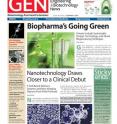GEN reports on the greening of the life sciences
Biopharmaceutical firms and other life science organizations are taking definitive steps toward creating greener working environments and developing more sustainable operations, reports Genetic Engineering & Biotechnology News (GEN). This promising trend was made clear through a series of presentations and panel discussions that took place at GEN's (www.genengnews.com/gen-articles/biopharma-s-going-green/3381), "GreenBioPharma" conference, which was recently held in Philadelphia. "The main message that emerged from our meeting was that going green is not only beneficial to the environment but that sustainable practices make good economic sense as well," said John Sterling, Editor in Chief of GEN.
Topics ranged from environmentally sensitive building design, air-quality monitoring systems, automation, energy efficiency, water-reduction strategies, biocatalysis to optimize process dynamics, and waste reduction and recycling. Many of the presentations emphasized the operational efficiencies and sustainable advantages of switching to disposable technologies across the process stream, including savings in labor, energy, water, chemical use, and overall costs.
Beth Junker, Ph.D., senior scientific director in bioprocess R&D at Merck, encouraged companies to assess the environmental footprints of their chemical processes—such as the aquatic toxicity of heavy metals—early in the product life cycle. Dr. Junker identified three main opportunities for waste (including energy) reduction: process intensification, easing of purification bottlenecks, and a shift in focus in purification from product capture to contaminant removal.
A case study describing fermentation processes at Bayer Healthcare's Berkeley, CA, site, where Bayer's factor VIII is produced, identified "quick wins" in utility use reduction, followed by process changes using technology to increase efficiency and reduce cost-of-goods. These included increasing the height of chromatography columns (but staying within established process specifications to avoid the need for re-evaluation), which is predicted to increase yield by 5%, saving millions of dollars and reducing the carbon footprint of this unit operation by about 3%.
Life Technologies' internal energy-efficiency efforts are expected to save the company a projected $25 million between 2004 and 2012. Cristina Amorim, vp of global EHS and citizenship, told conference attendees that big savings can come from unexpected places. For example, historically Life Technologies had shipped its Applied Biosystems TaqMan® assays to customers in Styrofoam coolers. Looking for ways to reduce waste, the company performed stability tests and determined that the reagents could safely be shipped in regular packaging, eliminating the use of 100,000 coolers per year and saving the company $1.5 million/year.
Included among the other speakers at GEN's GreenBioPharma were representatives from GE Healthcare, Sartorius Stedim Biotech, Genentech, University of Pennsylvania, Intelligen, Ohio State University, Millipore, Diamond & Schmitt Architects, Clayco, Waters, Agilent Technologies, SciQuest, University of Maryland, Integrated Project Services, Hyde Engineering, RC Bio/Ingenza, and the University of Maryland.
Source: Mary Ann Liebert, Inc./Genetic Engineering News
Other sources
- GEN reports on the greening of the life sciencesfrom Science BlogThu, 2 Sep 2010, 17:56:19 UTC
